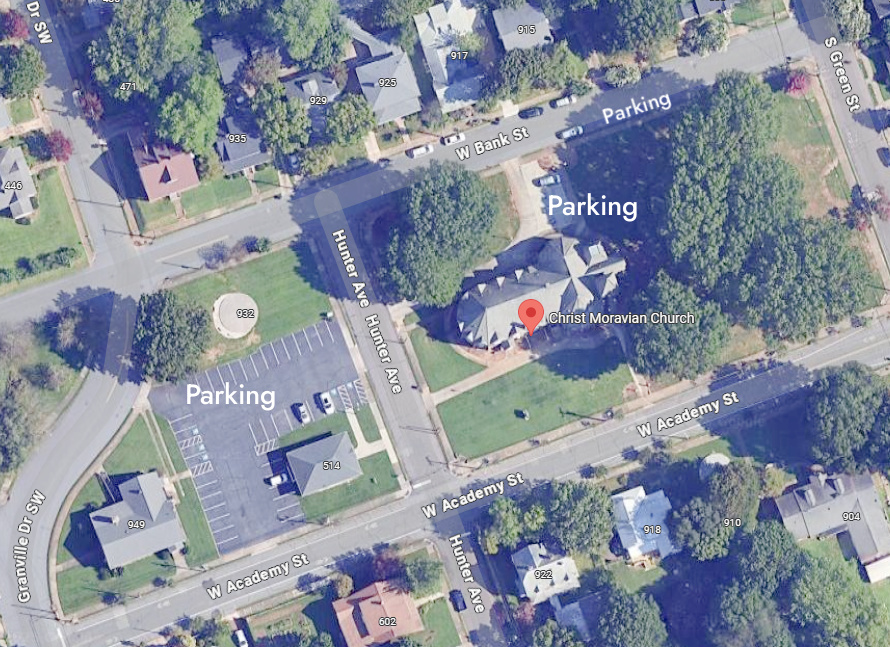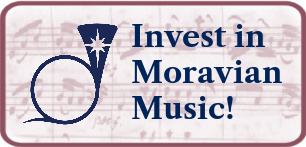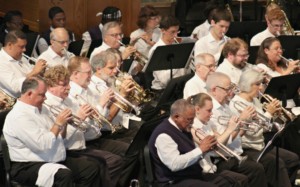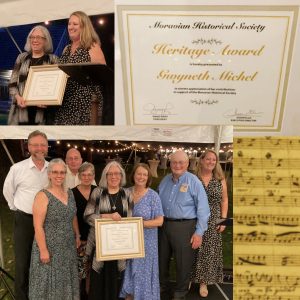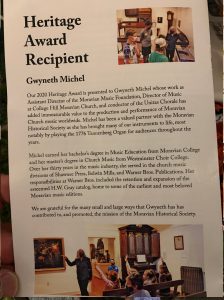Topic summaries:
- A Moravian Music Timeline – video of a lecture by Nola R. Knouse, is a quick ride through 600+ years of Moravian history through music.
- The 26th NC Regimental Band was not the only band with members from Salem, but it was the one put together in Salem and was therefore comprised of Moravians. In the Salem Band Collection, MMF holds the only known complete set of band books (of a Confederate band in the American Civil War).
- Moravian Bands in America began as SATB trombone choirs and added other instruments as valves were introduced and as the fashions changed. Many Moravian churches today have bands that play for preludes, festive occasions, services, and funerals. The Moravian Band is the oldest continuous mixed wind ensemble in the nation.
- Trombone Choirs (SATB) were popular in Germany (Posaunenchor) and Silesia at the time of the renewal of the Moravian Church (Unitas Fratrum). They were often used for vocal accompaniment, as they were made in all vocal ranges, SATB. The similarity of the instruments creates a unique tonal and timbral blend, close to the human voice. Trombones could play chromatically, unlike other brass in the 18th cent., prior to valve development in the 1830’s. They were weather-safe and were often used outdoors. SATB Trombone choirs played hymn polyphony which represents and reflects the equality/equity of the Moravian congregation settlement.
While many choirs morphed into mixed brass or wind bands, the Lititz and Glenwood Trombone Choirs have only slightly deviated by augmenting with some valved instruments. The Salem Trombone Choir and the Bethlehem Area Moravian Trombone Choirs still use trombones, exclusively. The Downey (CA) Moravian Trombone Choir was founded by Jeff Reynolds in 1965 and remained strictly SATB trombones throughout its 50 year history. - Community bands are popular near Moravian congregations and have taken on the standard form of the concert band, playing both sacred and secular repertoire. Many are led by Moravians and/or have several Moravian musician members. Some examples are the Salem Band, Advent-Hopewell Moravian Band, Triad Community Band (formerly, Bethabara Band), and the Winston-Salem Community Band (Winston-Salem, NC); and the Bethlehem Municipal Band (Bethlehem, PA).
- David Tannenberg was a prolific 18th century Moravian organ builder, learning his craft from Dresden-trained Joh. G. Klemm. He was based in Lititz, but provided musical instruments throughout Pennsylvania, New Jersey, Maryland, Virginia, and all the way to Bethabara and Salem, NC.
- C. F. Martin became a master guitar and instrument maker. He left Europe to be free of the restrictive guild system. After a few years in New York, he established a shop in the Moravian settlement of Nazareth, PA and the company has been crafting the world’s finest instruments there since 1838.
- Irving Lowens Collection of Tunebooks and Songbooks – Irving Lowens (19 August 1916 – 14 November 1983) was an American musicologist, critic, and librarian in the Washington, D.C. area. He served as the chief music critic at the Washington Star newspaper, the Assistant Head of the music division of the Library of Congress, and the dean of the Peabody Institute in Baltimore. Lowens was president of the Music Library Association, executive board member of the American Musicological Society, and founder of the Music Critics Association and the Sonneck Society, later renamed the Society for American Music. His main interests and scholarly works concerned American tunebooks, of which he held a significant collection. This collection of 1100+ volumes now resides at the Moravian Music Foundation in Winston-Salem, NC.
